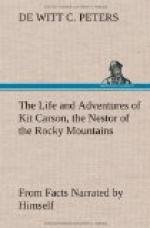The great results which should have been brought about by the teachings of Colonels Fauntleroy and St. Vrain, by this weak diplomacy, were more or less frustrated. These gentlemen, however, had won great renown. They had the savages driven to such extremes that one more expedition, led by them in person, would have subdued all their obstinacy and made them over anxious for peace. The Indians had been seven times caught, and, on every one of the occasions, they had been greatly worsted. They had lost at least five hundred horses, all their camp equipage, ammunition, provisions, and most of their arms, and were indeed almost at the mercy of the whites. Under these circumstances they should have been shown true magnanimity and greatness, by forcing them into that course which was and is for their own welfare as well as the welfare of the country, and against which, they themselves so blindly contend. Say to an Indian, that ere many years have passed by the buffalo will all be destroyed, and he will answer you “that the ‘Great Spirit’ rains them down in the mountains for his red children.” This is a fair example of the manner in which most of them listen to the voice of reason. It requires practical and active demonstrations by means of rifles and other weapons to teach, them that they will not be permitted to plunder and murder at pleasure. The wrong of this conduct they are as well aware of as their white brethren. It is by rifle arguments that their treaties become worth the value of the paper upon which they are written.
It is a well known fact that people who live in Indian countries prefer to have the red men at war, rather than bound to peace by such slender ties as they are usually called upon to take upon themselves. In the former case, the settler knows what to expect and is always prepared for the worst so far as it lies in his power; but, in the latter position, he is continually exposed to the caprices of a race who are in many respects as changeable as the very air they breathe.
In the old Mexican town of Don Fernandez de Taos, as we have before said, resides at the present time Kit Carson. A stranger entering this town, and especially at a little distance from it, is reminded of a number of brick-kilns just previous to being burnt, and all huddled together without any regard being paid to symmetry. In order to reach the Plaza, which is the main feature of attraction belonging to the town, the traveler is obliged to follow the crooks and turns of several unattractive streets. The home of Kit Carson faces on the west side of this public square. It is a building only one story in height; but, as it extends over a considerable space of ground, it makes up in part this defect, and within, it is surpassed by but few other houses in the country for the degree of comfort which is furnishes to its occupants. On most any fair day, around the doors of this house may be seen many Indians of various tribes who are either waiting for their companions within, or else for the opportunity to present itself so that they themselves can enter.




